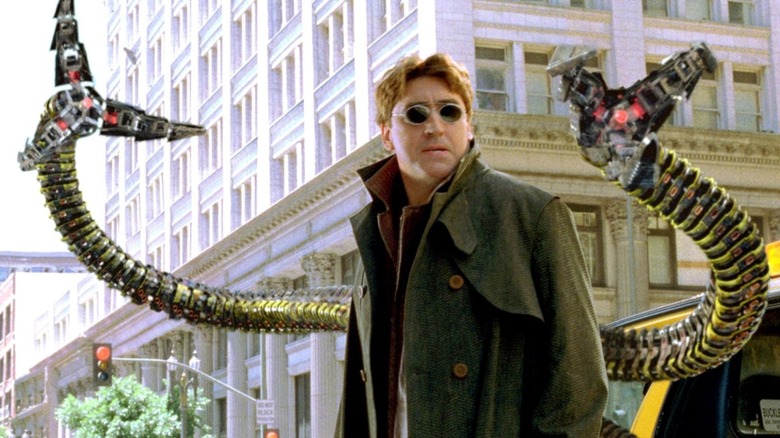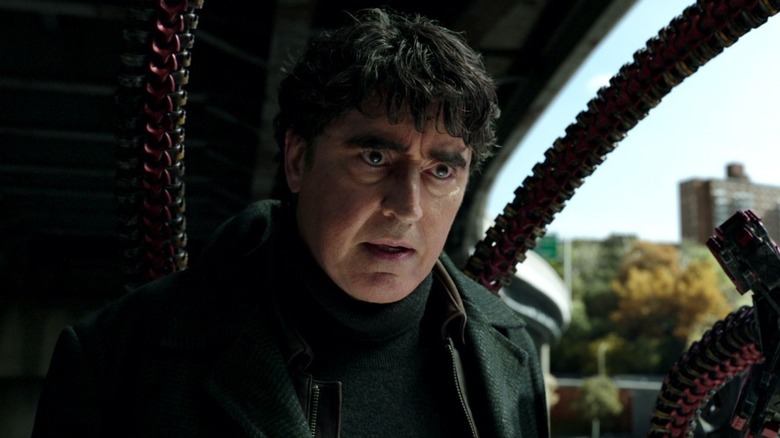Alfred Molina Was A Little Too Attached To His Doc Ock Tentacles
Alfred Molina has been the talk of the town lately, thanks to his return as Doc Ock, one of Spider-Man's most formidable foes on the silver screen in Sam Raimi's "Spider-Man 2," arguably the greatest superhero film ever made. Dr. Otto Octavius and his villainous alter ego, Doctor Octopus, has long been one of the web-slinger's most prominent adversaries, and he became even more menacing in "Spider-Man: No Way Home." But like many Spider-Man villains, Molina imbued the comic book villain with such warmth that, despite being a deadly adversary, he wasn't beyond redemption.
Before his villainous turn,, Dr. Otto Octavius was a mentor figure to Peter Parker and befriended him while working on his fusion power project for Oscorp . Of course, things went wrong at a demonstration after his experiment causes a power spike, killing Octavius' wife and corrupting the inhibitor chip on the back of his neck that kept the tentacle arms with artificial intelligence in his control. The nearly indestructible arms twist his mind, driving him to blame Spider-Man for the experiment gone wrong, and sending him on a mission to perfect the dangerous experiment. Unfortunately, that mission puts him directly on a path to squash the webslinger once and for all.
As the main antagonist of "Spider-Man 2," Alfred Molina spent a great deal of time with his tentacled limbs, and he might be a little more attached to them than you might imagine.
The Tentacles Have Names
Believe it or not, the electronically-powered, titanium-steel tentacles attached to Alfred Molina as Doc Ock each have names. Before the release of "Spider-Man 2" in 2004, the legendary actor shared with The Associated Press that he nicknamed his extra limbs while filming the Sam Raimi sequel. They're not villainous names either. Instead, Molina chose casual, not-so-scary monikers for his mechanical appendages.
Doc Ock's tentacles are named Harry, Larry, Flo, and Moe.
Molina distinguished them depending on their strength. For instance, Harry and Larry were the "lower extremities," which helped him hurl cars through the windows of streetside coffee shops. "They were bigger and heavier," the actor described.
On the other hand, Flo and Moe were "slightly smaller, still very powerful." Flo rested on his right shoulder and "had all the delicate, intricate stuff to do," such as removing Dr. Octavius' glasses and lighting a cigar for him.
Harry, Larry, Flo, and Moe got quite the upgrade in "Spider-Man: No Way Home," after they came into contact with Tom Holland's nanotech Spider-Man suit given to him by Tony Stark. Eventually, Peter would use his suit to take control of his foe's tentacles, with the red nano-tech accenting the arms, seizing command of the villain's mechanical limbs. But eventually, Doc Ock isn't the villain.
After being held against his will, Octavius returns to his normal self after Peter creates a new inhibitor chip to replace his damaged one, ensuring that he regains control of his mind and losing the influence of his metal arms. Otto is nearly brought to tears when the sinister voices in his head turn to silence. It's a truly redeeming moment for his character, and Spidey fans see once again that Doc Ock has always been a reluctant villain. In fact, when all is said and done, he turns out to be a hero.

